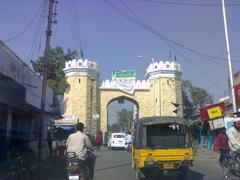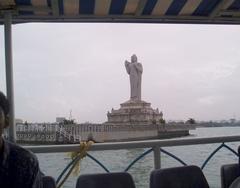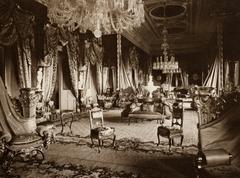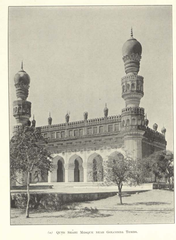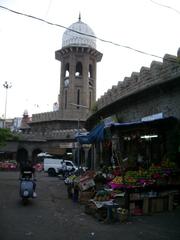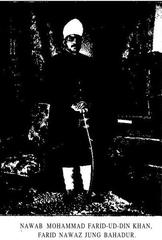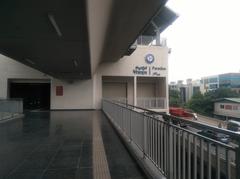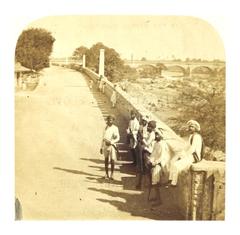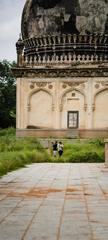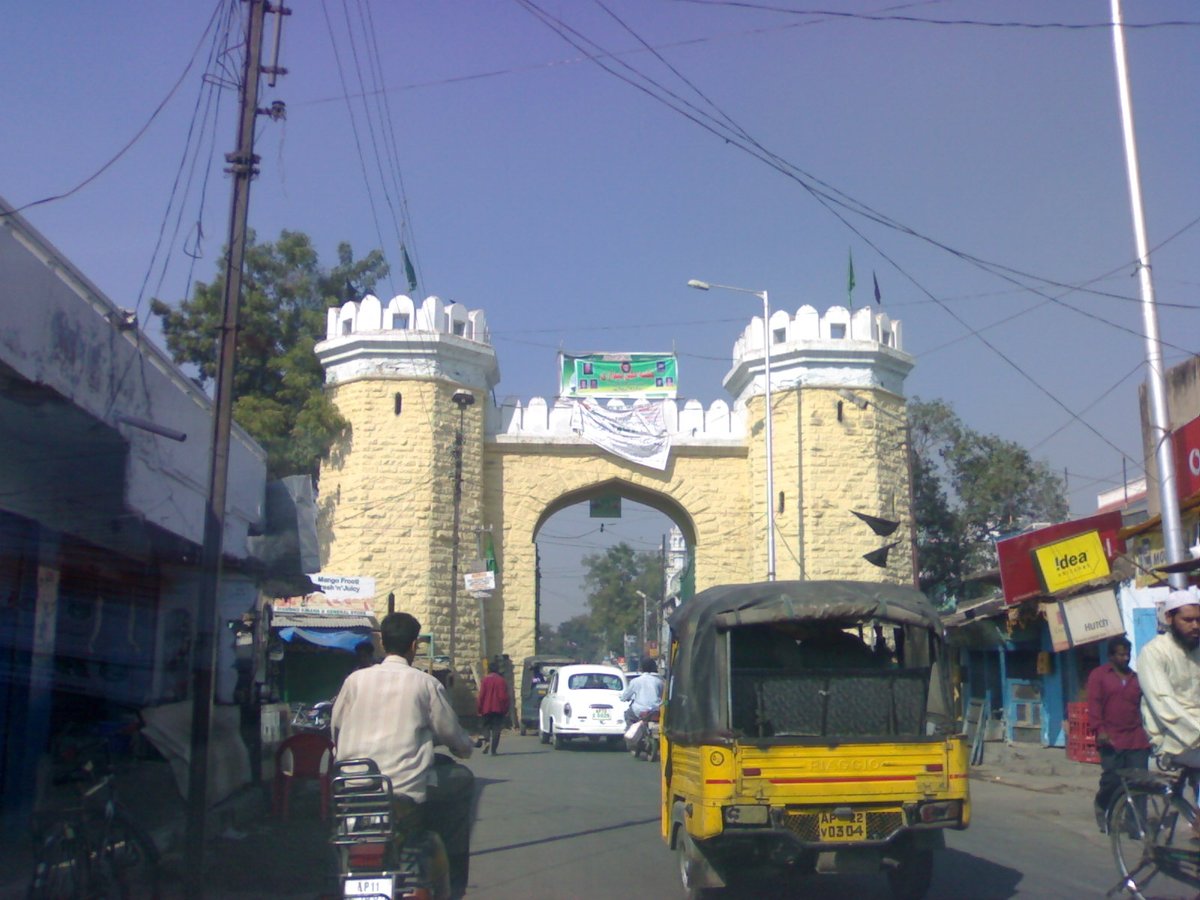
Dabirpura Gate: Visiting Hours, Tickets, and Historical Significance in Hyderabad
Date: 14/06/2025
Introduction
Dabirpura Gate, prominently situated on the southeastern edge of Hyderabad’s historic old city, is a living testament to the city’s rich cultural tapestry and fortified heritage. Constructed in the early 18th century under Nizam-ul-Mulk Asaf Jah I, it was integral to the city’s original defensive walls—once fortified by thirteen grand gates and numerous posterns. Its robust architecture, blending Indo-Islamic and Deccani styles, and its continued prominence amid modern urban sprawl, make Dabirpura Gate an essential site for historians, architecture enthusiasts, and travelers alike.
This guide provides a detailed overview of Dabirpura Gate’s historical background, architectural features, visitor information (including visiting hours and ticket details), preservation status, and practical travel tips. Whether you are a first-time visitor or a heritage aficionado seeking deeper knowledge, this resource will help you maximize your experience at one of Hyderabad’s enduring landmarks. For further exploration, official heritage resources and virtual tours are available (Heritage Hyderabad, Google Arts & Culture).
Table of Contents
- Discover Dabirpura Gate: Hyderabad’s Historic Landmark
- Historical Background and Origins
- Architectural Features and Urban Context
- Preservation Status and Conservation Challenges
- Visiting Dabirpura Gate: Hours, Tickets, and Accessibility
- Nearby Attractions and Amenities
- Local Culture, Events, and Food
- Photographic Spots
- Frequently Asked Questions (FAQs)
- Conclusion
- Visual and Interactive Resources
- References & Useful Links
- Call to Action
Discover Dabirpura Gate: Hyderabad’s Historic Landmark
Dabirpura Gate is a striking reminder of Hyderabad’s fortified past. As one of the few surviving gateways, it connects modern visitors to the city’s era of walled defenses and bustling trade. Its imposing arches and architectural details invite exploration, while the lively markets and neighborhoods nearby offer a vibrant cultural immersion.
Historical Background and Origins
Hyderabad’s old city, founded in 1591, initially flourished without fortifications. After the Mughal conquest in 1687, the need for security led to the construction of defensive walls and gates. Dabirpura Gate’s origins trace back to the early 18th century, with initial construction during Mughal Subedar Mubariz Khan’s tenure and significant expansion under the Asaf Jahi dynasty. By the reign of Nizam-ul-Mulk Asaf Jah I, the fortifications enclosed approximately 4.5 square miles and featured thirteen gates, with Dabirpura Gate serving as a key southern entry point for commerce and defense (The Hindu).
Architectural Features and Urban Context
Construction and Materials
Dabirpura Gate is primarily constructed from durable granite masonry and lime mortar, reflecting local traditions and the need for resilience. Its robust structure is accentuated by thick walls, broad arches, and two octagonal bastions. Over time, layers of yellow and white paint have been added, masking the original stonework (Uniquely Telangana).
Defensive Elements and Stylistic Influences
The gate’s crenellated parapets and bastions were designed for defensive surveillance, with internal staircases leading to watchtowers. While utilitarian in appearance compared to more ornate gates, Dabirpura Gate’s design exemplifies Indo-Islamic and Deccani architectural influences from both the Qutb Shahi and early Asaf Jahi periods (Wikipedia).
Surviving Features
Despite urban encroachment and the loss of most city gates, Dabirpura Gate remains intact, with remnants of the original city wall visible nearby. Together with the Puranapul Darwaza, it offers rare insight into Hyderabad’s fortified urban landscape (The Hindu).
Preservation Status and Conservation Challenges
Current Condition
Dabirpura Gate exhibits signs of aging, including cracks, weathering, and paint that obscures original masonry. The staircases and bastions are accessible but in need of maintenance, and the absence of interpretative signage limits educational value (Uniquely Telangana).
Conservation Efforts
Heritage activists and organizations, such as INTACH, advocate for gentle cleaning and minimal intervention to maintain authenticity. Recommendations include using chemical cleaning to reveal the granite, structural repairs with compatible materials, and improved signage for public awareness (The Hindu).
Urban Pressures
The gate is surrounded by busy roads, commercial activity, and modern buildings, exposing it to pollution, vibrations, and potential encroachment. Regular monitoring and community-led preservation are vital for its protection (Uniquely Telangana).
Visiting Dabirpura Gate: Hours, Tickets, and Accessibility
- Visiting Hours: Dabirpura Gate is open to the public daily from 6:00 AM to 8:00 PM.
- Tickets: Entry is free of charge.
- Accessibility: Easily reachable by public transport (buses, MMTS, auto-rickshaws, and taxis). The ground level is accessible, but stairways to watchtowers may not suit visitors with mobility impairments.
- Best Time to Visit: Early mornings (7:00–10:00 AM) or late afternoons (4:00–7:00 PM) for pleasant weather and optimal lighting.
Guided Tours and Local Travel Tips
While no official guided tours operate solely at Dabirpura Gate, it is frequently included in local heritage walks and Old City tours. Bookings are available through local operators and travel agencies. Combine your visit with nearby attractions for a comprehensive heritage experience.
- Travel Tips:
- Wear comfortable shoes and modest clothing.
- Carry water, especially in warmer months.
- Respect the monument and avoid climbing fragile sections.
- Engage with local shopkeepers and residents for insights.
Nearby Attractions and Amenities
Dabirpura Gate’s prime location links visitors to several nearby cultural and historical sites:
- Charminar: Hyderabad’s iconic monument (approx. 10–15 min walk).
- Laad Bazaar: Bustling market for bangles and crafts.
- Mecca Masjid: One of India’s largest mosques.
- Salar Jung Museum: Renowned for its extensive art and artifact collections.
- Chowmahalla Palace, Purani Haveli, Nayapul, and Begum Bazaar: Each offers unique glimpses into Hyderabad’s royal, commercial, and multicultural history.
Refreshments are available at nearby tea stalls, bakeries, and local eateries, where you can sample Irani chai, Osmania biscuits, and Hyderabadi biryani.
Local Culture, Events, and Food
The area surrounding Dabirpura Gate is known for its diverse communities and vibrant traditions. Festivals such as Eid, Muharram, and Milad-un-Nabi bring the neighborhood to life with processions and celebrations. Traditional eateries, historic schools, and legacy bakeries add to the locality’s charm. Although historic venues like Chaman ki Hotel no longer exist, their cultural legacy endures in local stories and cuisine.
Photographic Spots
Capture the gate’s architectural details, the energy of adjacent markets, and panoramic views from the Dabeerpura Flyover. Morning and evening light best accentuate the historic stonework and lively urban scenes.
Frequently Asked Questions (FAQs)
Q: What are the visiting hours of Dabirpura Gate?
A: The gate is open daily from 6:00 AM to 8:00 PM.
Q: Is there an entry fee?
A: No, entry is free for all visitors.
Q: Are guided tours available?
A: Dabirpura Gate is included in many local heritage walks but does not have its own official tours.
Q: How can I reach Dabirpura Gate?
A: Reachable by metro (Malakpet station), MMTS, buses, auto-rickshaws, and taxis.
Q: Is Dabirpura Gate wheelchair accessible?
A: The ground level is accessible, but some lanes and stairways may be challenging for wheelchair users.
Q: What attractions are nearby?
A: Charminar, Laad Bazaar, Mecca Masjid, Salar Jung Museum, Chowmahalla Palace, and more.
Conclusion
Dabirpura Gate is more than a relic of Hyderabad’s walled city; it is a dynamic symbol of resilience and cultural confluence. Its enduring architecture, strategic urban placement, and immersive surroundings make it a rewarding destination for both heritage seekers and casual visitors. With free access, convenient transport links, and proximity to major attractions, Dabirpura Gate offers a memorable journey through Hyderabad’s storied past and vibrant present.
Preserving and respecting this historic landmark ensures that future generations can continue to experience and learn from Hyderabad’s layered history. Plan your visit today to explore Dabirpura Gate and the captivating old city.
Visual and Interactive Resources
- Explore virtual tours and detailed maps: Heritage Hyderabad
- View high-resolution images and architectural details: Google Arts & Culture
- Related guides:
References & Useful Links
- Dabirpura Gate: A Historical Marvel and Must-Visit Hyderabad Historical Site, Heritage Hyderabad
- Dabirpura Gate: Visiting Hours, Tickets, and Architectural Heritage in Hyderabad, The Hindu
- Dabirpura Gate Hyderabad: Visiting Hours, Tickets, History & Travel Tips, Uniquely Telangana
- Qutb Shahi Heritage - Google Arts & Culture
- Official Hyderabad Tourism
Call to Action
Enjoy discovering Hyderabad’s heritage?
Subscribe to our newsletter for the latest updates on historical sites, cultural events, and guided tours. Download the Audiala app for interactive maps, travel tips, and exclusive content about Dabirpura Gate and more. Follow us on social media to stay connected to Hyderabad’s living history.
